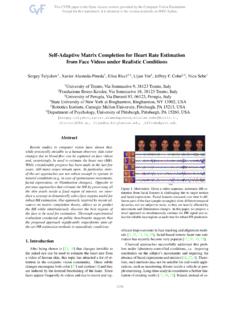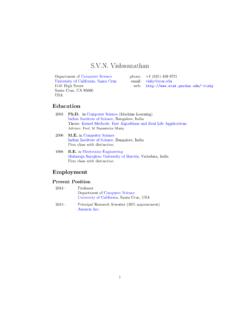Transcription of Environmental Assessment Sourcebook UPDATE
1 Environmental Assessment S o u r c e b o o k UPDATE . Environment Department December 1997. The World Bank Number 21. Environmental Hazard and Risk Assessment Many types of development supported by the Bank involve Environmental risk. For example, dam construction or remedial action to clean up pollution may pose risks to human health or the natural environment. Under such conditions, the potential Environmental impacts are often subject to uncertainties. Where these uncertainties are significant, for example in the case of a potential release of toxic material in a densely populated area, a quantitative Assessment of hazards and risks may be appropriate.
2 The techniques of hazard and risk Assessment have been developed to help determine the degree of uncertainty associated with development activities. These techniques may be used independently from or in support of Environmental Assessment (EA). and Environmental auditing, which they compliment. This UPDATE provides an introduction to hazard and risk Assessment , outlines some available methodologies, and discusses the use of these techniques in assessing Environmental liability. Background from automobiles, energy production and other in- dustrial processes (such as particulates, radionuclides, The origins of risk Assessment lie in military opera- estrogen mimickers and hydrocarbons); and biological tions research during World War II and thereafter in agents.
3 More recently, the concept of risk Assessment the avoidance of chemical and nuclear plant failure. has been extended to natural systems. Such ap- More recently, notorious industrial accidents such as proaches include assessing risks to ecological re- the 1976 dioxin release in Seveso in northern Italy and sources, or investigating the risks arising from natural the 1984 methyl-isocyanate incident in Bhopal, India, disasters such as floods and earthquakes. have accelerated an extension of risk Assessment to the control of major industrial hazards. Legislative In the context of Bank development projects, risk and procedural developments in response to these di- Assessment deals with three basic questions: sasters have supported this trend, including the Euro- pean Economic Community (now European Union) 1.
4 What can go wrong? What impacts might affect Directive for Major Accident Prevention of 1982 and human health and the natural environment, and what the United States National Research Council's risk as- are the reasonable project scenarios (cause and effect). sessment framework of 1983 for the Environmental that might result in damage to health, the environ- Protection Agency (USEPA). ment or the financial viability of the project. The focus of risk Assessment on acute human health 2. What is the range and magnitude of these adverse issues arising from major industrial hazards was impacts? What number of people or geographical area broadened to encompass chronic health concerns.
5 Could be affected, what is the maximum credible acci- These include occupational health risks associated dent that could occur during the lifetime of the with the use of potentially harmful materials (such as project, and what are the risks of routine operations. carcinogens or teratogens), and broader chronic health concerns linked to Environmental pollution. The pol- 3. How likely are these adverse consequences? With lutants of concern in the wider environment include: what frequency might they occur, what evidence is potentially harmful industrial materials; emissions available to judge their likelihood, and what data are 1. Insert in UPDATE Binder chapter 11.
6 Available. For example what data exist for failure rates When should risk Assessment be used? of processes and technological components, or occur- rences of natural disasters. Where uncertainties associated with Bank investments are large and important to the outcome of an environ- The first two questions are partially addressed in mental Assessment (such as the potential release of toxic materials in a densely populated area, or likeli- EAs, whereas the third question is addressed by risk hood of seismic damage to a hydropower dam), a Assessment . The main objective of risk Assessment is quantitative Assessment of risks is appropriate. The to identify hazards and assess risks associated with Bank requires risk Assessment for projects involving development projects, and to recommend appropriate certain inflammable, explosive, reactive, and toxic risk management strategies.
7 The interactions between materials when they are present at a site in quantities hazards, risks and risk Assessment are described in box 1. above a specified threshold level (for guidance, see Technica, Ltd., 1988). Box 1. What is hazard and risk Assessment ? The Bank has also employed risk Assessment to In simple terms, hazards refers to sources of potential evaluate the linkages between Environmental pollu- harm, whereas risk considers frequency and severity tion and other health determinants. In addition, risk of damage from hazards. A risk Assessment involves evaluating actual and perceived risks as the basis for Assessment has been used to assist developing coun- decisionmaking.
8 Tries in allocating limited resources to pollution pre- vention, control and management, for example in Hazard denotes a property (of substances, microor- Bangkok and Manila. ganisms, and so on) or a situation that in particular circumstances could lead to harm. If these circum- Bank Group involvment with existing private en- stances occur, they result in adverse consequences. terprises (either through privatization loans, lending Hazard Assessment is thus the identification of hazards, via financial intermediaries, or investment by the IFC). their potential receptors (people, natural resources, increases the likelihood of project Environmental li- plants or animals) and the determination of the con- sequences.
9 Ability. This is most commonly associated with histori- cal contamination arising from past activities at Risk is a function of the probability (or frequency) industrial or utility locations. A risk management of a hazard occurring, and the magnitude of the conse- approach is increasingly advocated for site investiga- quences ; risk therefore represents the likelihood of a tion and Assessment for the definition and identifica- potential hazard being realized. Risk estimation in- tion of contaminated land (see box 2). Other relevant volves identifying the probability of harm occurring project contexts are described below in conjunction from an intended action or accidental event.
10 Risk with a description of the types of risk Assessment . evaluation determines the significance of estimated risks, including risk perception (involving subjective appreciation and judgment), which will more often Stages in risk Assessment process than not bear little relation to a statistical probability of damage. Many formal and informal methodologies have been developed for risk Assessment . These vary from reli- Risk Assessment is a combination of risk estimation ability Assessment to mathematical and statistical and risk evaluation. The technique of risk Assessment modeling techniques. The general methodological se- may be used to assess the relative costs and benefits quence described below applies in most situations.















![arXiv:1508.07909v5 [cs.CL] 10 Jun 2016](/cache/preview/7/e/b/e/e/0/c/4/thumb-7ebee0c41df065536e32c7f48648dfa4.jpg)
